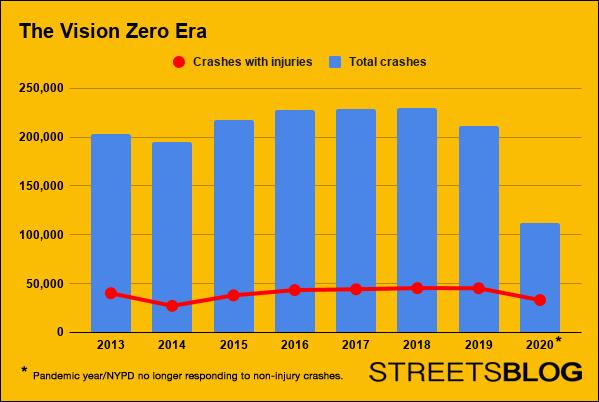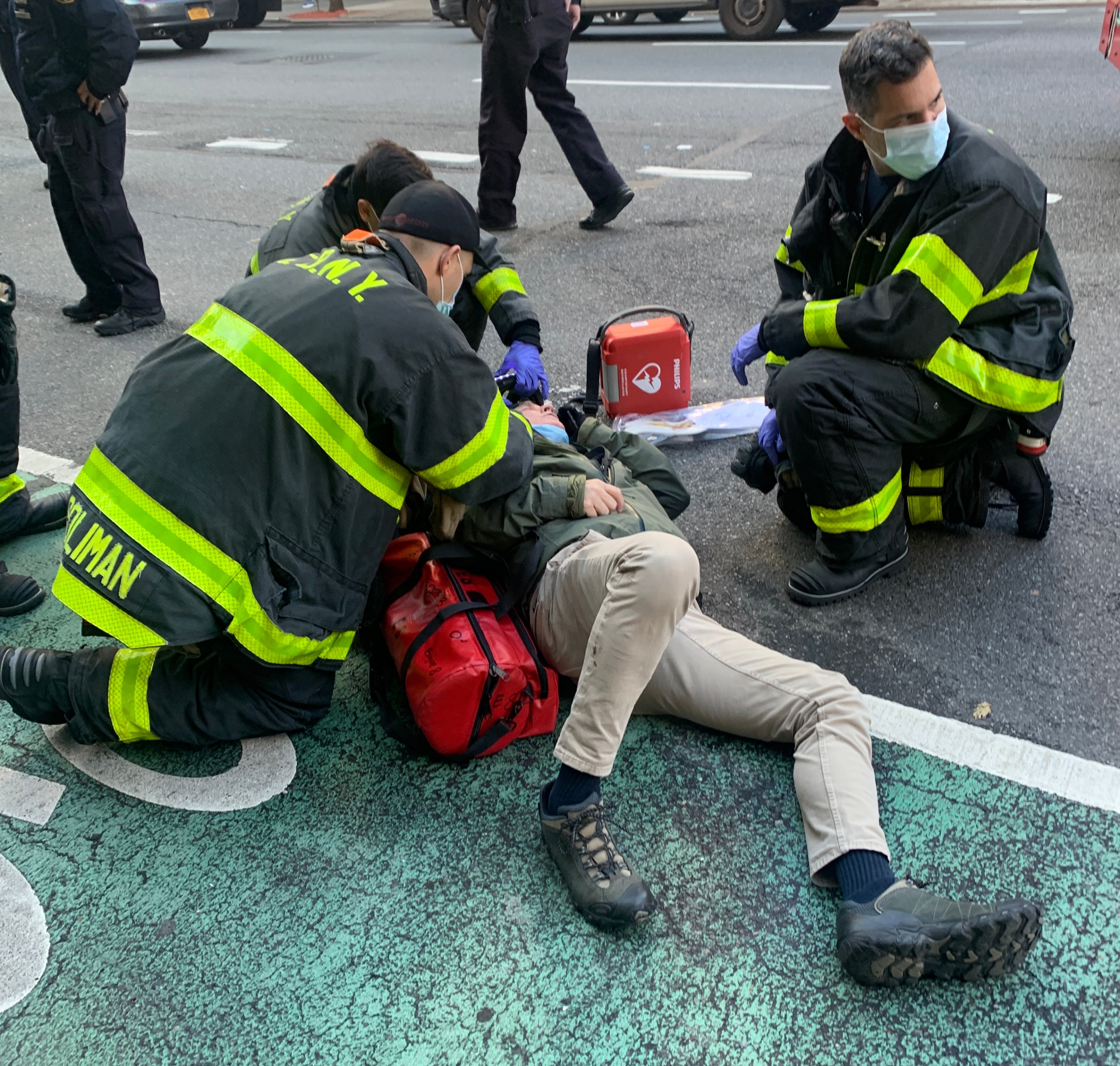April was the cruelest month — but the other months sucked, too.
Last month was the deadliest April since Mayor de Blasio took office in 2014 — and 2021, his last year in office, is on track to be the second deadliest year for road violence of his tenure, despite seven-plus years after the city officially adopted the Vision Zero initiative, according to a new data analysis to be released later today by Transportation Alternatives.
The TransAlt findings are both shocking and numbingly routine in a city with roughly 220,000 crashes every year causing roughly 45,000 injuries every year — numbers that haven't really changed much under de Blasio:
- Through April 30, 70 New Yorkers were killed in traffic violence — the deadliest start of any year since 2014 (when there were 72 fatalities).
- The pedestrian death toll is staggering: 43 pedestrians have been killed so far this year — the deadliest first four months for walkers of any year since Mayor de Blasio took office.
- Hot-spots are Brooklyn and Staten Island: So far this year 24 people have been killed in Kings and seven have been killed on the Rock — both records for the first four months of a year.
And then there are those April numbers: Last month, 25 people were killed on city streets, the bloodiest April since Mayor de Blasio took office.
Today we’re sharing new analysis of fatal crash data.
— Transportation Alternatives (@TransAlt) May 4, 2021
2021 is on track to be the second deadliest year in the entire de Blasio era.
#VisionZero is in crisis. @nycmayor, Albany & NYC's next leaders MUST deliver solutions to save lives.
Full details: https://t.co/QMQAZVDEAy pic.twitter.com/A06cDOvr6l
From almost the first week of his administration, the mayor has stated his commitment to Vision Zero — the traffic safety initiative that seeks to redesign roadways so they are safer for all users from the daily destruction of the automobile. The campaign has had intermittent success in reducing overall fatalities (such as in 2018, when the city recorded the fewest road deaths ever), but the city is only marginally closer to the zero of Vision Zero than it was before Bill de Blasio showed up.
For his seven-plus years, the mayor has never made Vision Zero a central focus of his administration, activists claim, because doing so would require a substantial reimagining of the role of the auto in city life. In 2019, during a wave of deaths, the mayor released a "Green Wave" plan, but it only fiddled on the edges, activists say, and, indeed, bloodshed continued during the coronavirus pandemic because of reckless driving on less congested roads.

The mayor has responded to such downturns in Vision Zero success as evidence that the city must do more — and activists reminded him of that on Tuesday.
“For the third year in a row, traffic violence is increasing because of Mayor de Blasio’s inaction,” said Danny Harris, executive director of Transportation Alternatives. “Since Mayor de Blasio took office, more than 1,000 pedestrians and cyclists have been killed on his streets — despite the city having both data about where crashes occur and the proven tools to address traffic violence. By withholding these tools, especially to communities most in need, Mayor de Blasio continues to prioritize the convenience of drivers over protecting human life. In his remaining time in office, he must put people, not cars, first on our streets, especially as New York City reopens. And, we urge those running to be the next mayor to advance bold plans to save Vision Zero and build streets for people.”
Harris said the solutions are obvious:
- Fast-tracking life-saving street redesigns on Queens Boulevard, Northern Boulevard, the Grand Concourse, Meeker Avenue, and other key corridors across the five boroughs.
- De Blasio should listen to his own Surface Transportation Advisory Council, which called for better buses, freight reform and more equitable distribution of protected infrastructure for the most vulnerable.
- The city must build permanent infrastructure that physically separates open streets from cars and creates more car-free spaces, as the TA-led Open Streets Coalition has demanded. [This effort is stalled, as Streetsblog has reported].
- The administration must allocate funding for the Streets Master Plan, a law that passed last year requiring the city to build 50 miles of protected bike lanes and 30 miles of bus lanes every year.
"Mayor de Blasio cannot leave these critical responsibilities to his successor," TransAlt said in a statement. Several candidates have signed onto the group's "NYC 25X25" plan to reclaim one-quarter of the public roadways space from drivers.
We had reached out to City Hall for comment on the specific statistics, and after initial publication of this piece, mayoral spokesman Mitch Schwartz said this:
“No question about it: these numbers are concerning, and there’s a lot more work to do to unlock the full power and promise of Vision Zero.”
We had asked City Hall for specific measures the mayor would order up in the wake of the TransAlt report, but instead got a statement about hw the mayor is asking Albany for help.
In addition to Schwartz's comment, the Mayor's Press Office also put out a statement saying that Mayor de Blasio now supports the Crash Victims Rights and Safety Act, which is actually a package of proposals advancing in the State Legislature (and covered by Streetsblog here).
The Crash Victims Rights & Safety Act includes:
- Traffic-Crash-Victim Bill of Rights — which gives crash victims rights like those of the federal Crime Victims’ Rights Act, including the right to receive timely crash reports and the right to attend crash-related hearings and submit impact statements. It would also require the state to report data about crash-victim compensation and support, including no-fault insurance and private insurance.
- Sammy’s Law — named for Samuel Cohen Eckstein (son of Amy Cohen), a 12-year-old from Brooklyn who was killed by a reckless driver in 2013, the bill would repeal a state regulation prohibiting New York City from lowering the speed limit below 25 mph (or 15 mph in school zones).
- Speed-Safety Camera Improvement — which would authorize New York City to operate speed-safety cameras 24/7, would escalate penalties for extreme repeat offenders, including license suspension, and would allow records of speeding to be shared with auto insurance companies. The city now may not operate the cameras outside of weekdays between 6 a.m. and 10 p.m., even as a recent NYC Department of Transportation report found that speed-safety cameras reduce speeding by 72 percent and injuries by 17 percent, and two-thirds of vehicles ticketed by safety cameras did not receive another violation in the same calendar year.
- Vehicle-Safety Rating — which would require the NYS DOT and the state Department of Motor Vehicles to create a safety-rating system to assess the risk a motor vehicle poses to vulnerable road users, and would require that such ratings be displayed at the point of sale and on a state website. No safety-rating system exists for risks a vehicle poses to people outside a car, which are especially acute for large, heavy vehicles. In New York City, 25 of the 29 cyclists who were killed in 2019 were killed by drivers of large trucks, buses, SUVs or vans.
- Dangerous-Driving “Rule of Two” — which would clarify existing law to address the “rule of two” — a “rule of thumb” in which prosecutors need to prove that the driver committed two separate moving violations such as speeding, running a red, failure to yield, etc. — in order to make it easier for the most reckless drivers to be held accountable under existing misdemeanor law (VTL 1212), especially when they injure or kill someone. The legislation would replace “reckless” with “dangerous” in “reckless driving” in order to avoid confusion with mens rea (state of mind) analysis.
- Blood-Alcohol Content Lowered to .05 — which would lower the blood alcohol concentration limit for driving from .08 percent to .05 percent, and for aggravated driving while intoxicated from .18 percent to .12 percent.
- Safe Passage for Cyclists — which would provide a clear objective definition of what a “safe distance” is for motorists when overtaking bicyclists on the road (at least three feet), provide a mechanism for accountability following a crash, and foster a culture of safer driving through education.
- A DMV Pre-licensing Course — which would require instruction in pedestrian and bicyclist safety as part of drivers’ pre-licensing courses and would educate new drivers on how to safely pass bicyclists on the road and the dangers that large multi-ton vehicles pose to pedestrians, bicyclists, and other vulnerable road users.
De Blasio's support for the package came after the funeral of Police Officer Anastasios Tsakos, who was killed by a reckless driver last month when he was on duty helping deal with the wreckage of a different crash.
"We must pursue fundamental changes. In honor of Officer Tsakos, I’m calling on the State Legislature to immediately pass the Crash Victims Rights and Safety Act,” the mayor said. “For Officer Tsakos and every victim of traffic violence on our streets, let’s deliver on the full power and promise of Vision Zero and keep our streets safe for generations of New Yorkers to come.”






